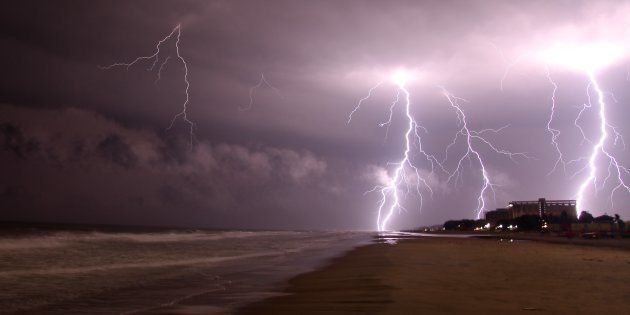
Besides the threat of drowning and injuries caused by flooding, there's one phenomena people forget: lightning. Environmental Affairs Minister Edna Molewa said in 2015 at least 100 people are killed by lightning every year in South Africa.
While people generally know the rules of safety during thunderstorms, such as not being in an open field when you see lightning, or not to use a tree as shelter during rain, South Africa is considered one of five most dangerous places on earth for lightning.
"People in rural areas are often affected more by lightning than those in urban areas due to the fact that people spend most of their times outdoors and have insufficient shelter to protect them from lightning," says Morne Gijben, research scientist from the South African Weather Service.
The eastern parts of the country are more prone to lightning-producing storms, says the SA Weather Service.
Informal settlements in rural and urban areas remain most vulnerable. In urban areas, informal settlements are particularly vulnerable to lightning as the structures provide little protection.
"Lightning victims in urban areas are often outdoors at the time of strikes, with no chance to take shelter in a fully enclosed building," Gijben added.
And before you think everyone knows that metal acts as a lightning rod, or that it's obvious that the safest place to be during a thunderstorm is indoors, think about this: StatsSA reported in 2013 that one in five South Africans walk all the way to work, while more than half of South Africa's children walk to school. That distance often includes crossing parks and fields to get to your destination faster, with no shelter to seek refuge in during thunderstorms.
Furthermore, bare earth and not just metal puts you at risk.
The SA Weather Service has offered a checklist of things to do when thunderstorms occur:
- If you are outdoors when you see or hear a thunderstorm coming, seek shelter immediately.
- Seek shelter with non-conducting floors. In a shelter that has no floor (bare earth) or with a good conducting surface, you're at risk of lightning striking nearby. The charge can strike through the ground into the shelter.
- If your hair stands on end, leave the area as fast as possible, as lightning will almost certainly strike that spot shortly.
- When you see the lightning FLASH, count the seconds until you hear the BANG of the thunder. Suspend all outdoor activities at 30 seconds and seek safe shelter, as lightning strikes are close. If you count 15 seconds or less, a lightning strike could occur where you are.
Unsafe areas during an electric storm are:
- Tall structures such as lone trees, telephone and power lines.
- Hilltops.
- Isolated sheds.
- Open water.
- Unprotected gazebos or picnic shelters.
- Avoid being near or touching: metal objects such as fences, golf carts, bicycles, and motorcycles, telephone or power lines and steel structures such as pylons and windmills.
- If indoors during a storm, stay well clear of windows and doors.
- Do not hold any metal objects, use any electrical appliances or be near electrical wires, use the telephone or take a bath or shower.
- If you are travelling, stay in the vehicle with your windows closed. A motorbike or bicycle is not a closed vehicle! Seek shelter under a bridge.
- Do not swim during a thunderstorm.
- Do not play sport during thunderstorms. Golfers and fisherman are at high risk.
There is more than one way to be electrocuted by lightning. Read this for a guide on the five different ways in which you can get struck.
If you're still not convinced of the danger of lightning, these stories of strikes in South Africa might convince you:
